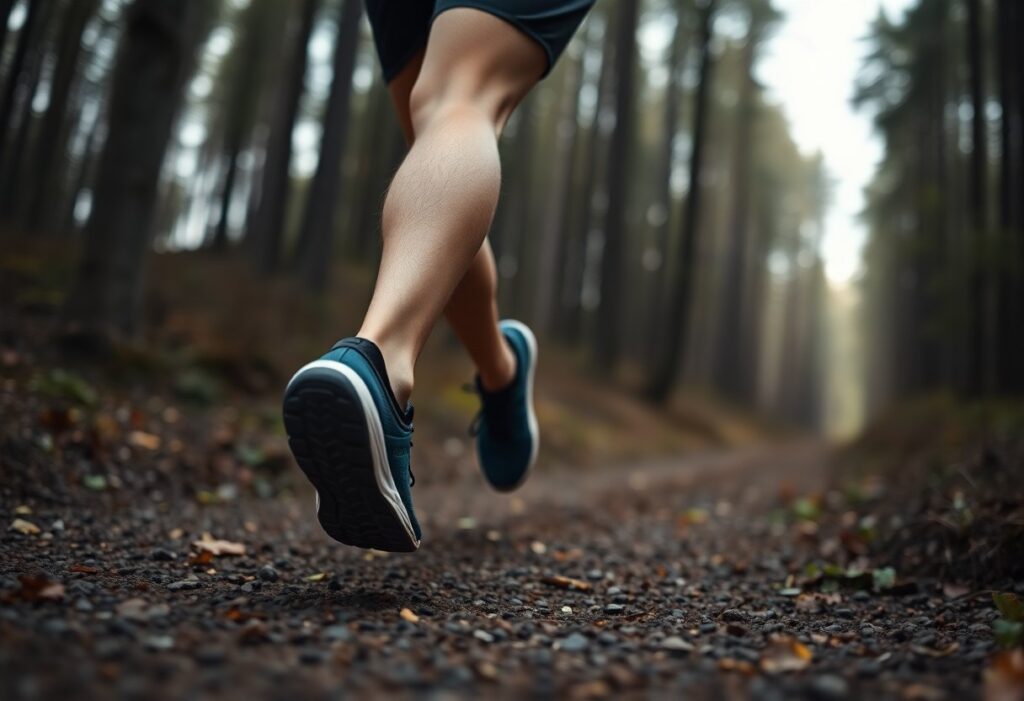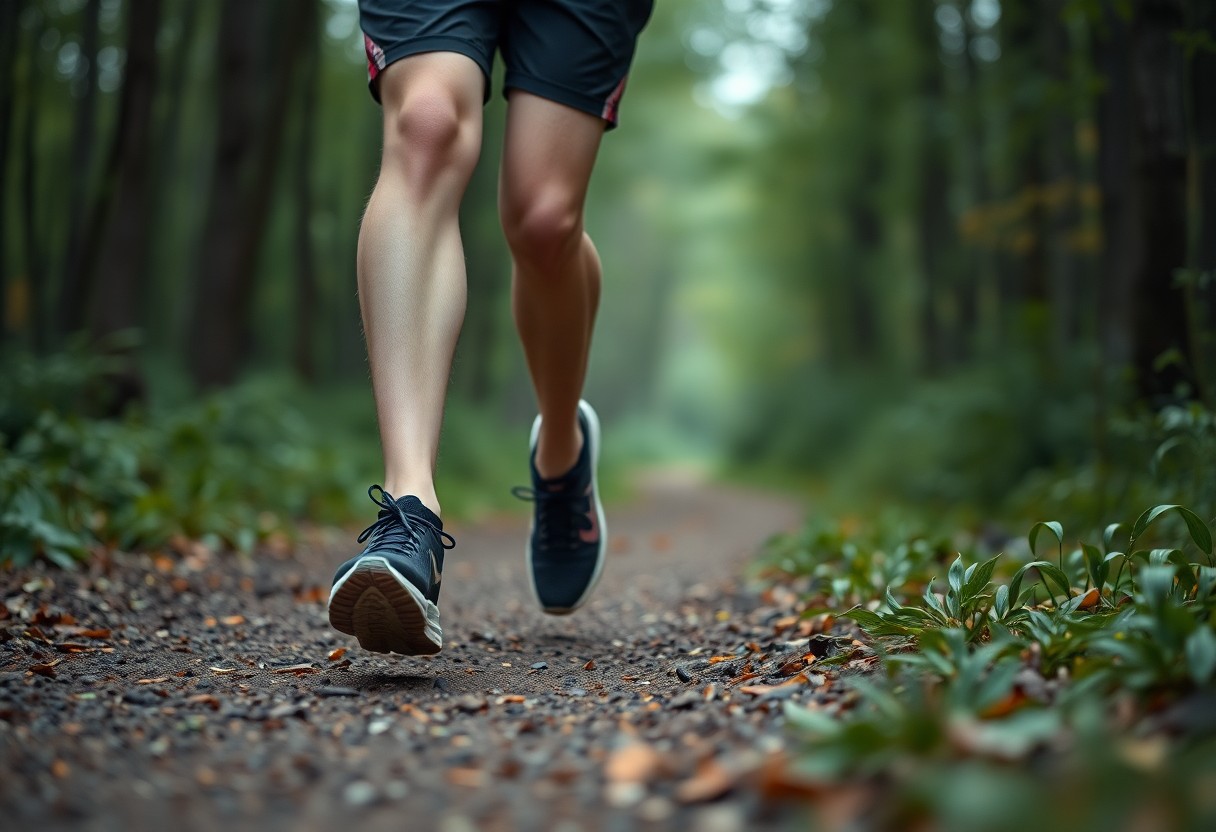
The alarming challenge of injury rates among trail runners can escalate to an astonishing 62% each year, often linked to the choice of unsuitable footwear. Understanding the biomechanics of minimalist footwear and its interaction with uneven terrain is crucial for enhancing your performance while reducing the risks associated with running. Utilizing wearable technology can accurately track essential metrics such as foot strike dynamics and load patterns, while personalized training programs are crafted to improve foot strength and endurance. This article explores how to leverage biomechanical insights and advanced technology to effectively implement injury prevention strategies.

Enhance Your Trail Running Experience with Minimalist Footwear
Addressing the unique challenges of trail running on diverse and rugged terrains while wearing minimalist footwear goes beyond merely selecting the right shoe; it requires an in-depth understanding of your individual biomechanics. Not recognizing the specific demands posed by different surfaces can substantially increase your risk of injury. As foot strike patterns and descent mechanics vary significantly, adjusting your running technique accordingly is essential for maintaining peak performance and minimizing the chances of setbacks.
Gain Insights into Biomechanical Foot Strike Patterns on Technical Trails
When traversing complex landscapes, foot strike dynamics can differ markedly. Runners who opt for minimalist footwear frequently exhibit a remarkable 23% greater prevalence of midfoot strikes on irregular trails, in stark contrast to the mere 8% observed with traditional running shoes. This adaptation can enhance your stability on challenging surfaces; however, it also entails a 37% increase in metatarsophalangeal joint flexion angles, emphasizing the necessity of fortifying your foot muscles to enhance endurance and lower the risk of injuries.
Assessing the Impact of Descent Mechanics and Ground Interaction
The mechanics involved when descending from elevations play a critical role in influencing your performance and injury risk during trail running. Utilizing minimalist footwear can lead to a striking 42.191 BW/s increase in vertical loading rates on steep 15% declines, especially when compared to flat asphalt surfaces. Moreover, this surge in loading results in more intense lateral toe engagement — noted to be 11% greater on loose gravel than on solid surfaces, highlighting the increased demands on the structural integrity of your feet during descents.
As you navigate technical trails in minimalist shoes, the biomechanics of your feet engage distinctly. The heightened vertical loading rates during descents can lead to increased fatigue within your foot muscles, subsequently raising your vulnerability to injuries. Additionally, significant alterations in toe splay patterns necessitate improved proprioception and muscle coordination, ensuring you remain responsive to the varied terrain beneath your feet. By focusing on these factors, you can effectively prime your body to tackle the challenges posed by diverse trails and optimize your overall running performance.
Identifying the Challenges of Wearable Technology in Trail Running
Although wearable technology has revolutionized the field of trail running, it still presents significant challenges regarding the precise tracking of performance metrics. The variability of terrain conditions, including steep declines and uneven surfaces, complicates data collection and interpretation. For example, wearable devices often struggle to provide consistent vertical oscillation measurements due to inconsistent ground conditions, leading to potentially misleading insights about your gait and overall running efficiency.
Analyzing Data Accuracy Discrepancies Among Leading Performance Devices
Considerable discrepancies in data accuracy have emerged among top performance tracking devices. A study conducted in 2024 revealed a 12.4% variance in power measurements on 10% inclines between the Stryd and GARMINRP devices, despite both displaying high intra-device reliability (ICC=0.89). Such inconsistencies can lead to misguided perceptions regarding your training load and overall performance, potentially obstructing your ability to enhance your trail running capabilities.
and GARMINRP devices, despite both displaying high intra-device reliability (ICC=0.89). Such inconsistencies can lead to misguided perceptions regarding your training load and overall performance, potentially obstructing your ability to enhance your trail running capabilities.
The Dangers of Miscalculating Training Load
Miscalculations in training loads can escalate by as much as 23% on mixed-terrain routes, directly affecting your injury risk and performance progression. This error often stems from inaccurate data interpretations during technical descents or uneven terrains, causing reliance on potentially flawed metrics. Such discrepancies can result in overtraining or inadequate load management, significantly raising your chances of sustaining an injury while running.
When navigating complex trail surfaces, the disparity between measured and actual exertion can skew your training insights. If your device underreports your exertion, you might inadvertently push beyond your limits, resulting in heightened fatigue and delayed recovery. Conversely, if your training load is overestimated, you may adopt a more cautious approach, inadvertently hindering your performance gains. In summary, ensuring that your wearable technology informs rather than misguides your training strategy is crucial for maintaining both your performance and overall health in the dynamic realm of trail running.
Exploring the Gender-Specific Dynamics in Trail Running Biomechanics
Understanding the biomechanical differences between male and female trail runners can greatly improve performance and reduce injury risks. Research indicates that anatomical and physiological differences affect shoe selection, gait patterns, and injury susceptibility. Customizing footwear and training programs based on these gender dynamics fosters safer and more effective outdoor running experiences.
Examining Gender-Specific Biomechanical Responses After Exercise
Post-exercise, female runners have shown a 19% increase in lateral forefoot pressures compared to their male counterparts following 5km barefoot runs. Furthermore, they display a 22% reduction in navicular drop during 50km ultra-marathons, indicating that their biomechanical adaptations to trail running differ significantly. Recognizing these patterns is vital for improving footwear design that caters to the unique biomechanics of female runners.
Implementing Tailored Solutions to Address Gender-Specific Challenges
To effectively tackle the unique biomechanics of female runners, it is essential to introduce customized solutions that consider their specific physical attributes. Tailoring training programs, using gender-appropriate footwear, and enhancing strength training regimens can markedly reduce injury rates while improving running performance. For instance, integrating exercises that focus on intrinsic foot muscle endurance and stability can be particularly beneficial for women, who may experience different loading patterns on technical terrains.
By analyzing data from various studies and incorporating findings on gender-specific responses, you can better focus on training and footwear that actively support your unique biomechanics. For example, leveraging targeted strength training regimens that improve the lower leg and foot can help your body adjust to the increased demands of trail running, especially for women who often experience heightened pressure in the forefoot region. Selecting shoes specifically designed for your unique foot mechanics can further help address common injuries, ultimately creating a more rewarding and sustainable trail running experience.

Utilizing Cutting-Edge Approaches for Real-Time Gait Analysis
Your running performance and safety can be dramatically enhanced by implementing real-time gait analysis through advanced technological methods. By employing integrated systems and wearable devices, you receive immediate feedback regarding your foot strike patterns, body mechanics, and overall movement efficiency. These sophisticated tools are designed to deliver actionable insights while you are actively on the trail, enabling you to dynamically modify your technique and prevent repetitive strain injuries commonly associated with improper running form.
The Importance of Embedded Sensors in Injury Prevention
Embedded sensors within footwear are integral to preventing injuries. They continuously monitor your foot strike patterns and pressure distributions in real-time, allowing for immediate corrective feedback. This advanced technology enables you to detect deviations from optimal running mechanics before they escalate into serious injuries. With a mere 19-millisecond latency in ground contact alerts, you receive timely notifications that assist you in maintaining alignment with biomechanical standards essential for injury prevention.
Long-Term Studies Show the Effectiveness of Biometric Feedback Technologies
Longitudinal studies indicate significant improvements in injury rates among trail runners who utilize biometric feedback technologies. Over a six-month period, athletes experienced a 37% reduction in aberrant loading patterns due to consistent monitoring and adjustments based on real-time data. This compelling evidence underscores how ongoing engagement with these technologies can enhance your running economy and resilience, thereby reducing the likelihood of injuries linked to gait irregularities.
For instance, a comprehensive study involving 250 trail runners documented the effectiveness of wearable sensors in identifying patterns that lead to overuse injuries. Runners who actively engaged with feedback systems reported a 30% lower incident rate of common injuries such as plantar fasciitis and Achilles tendinitis compared to those who relied solely on traditional training methods. Emphasizing continuous tracking, coupled with targeted adjustments based on data insights, highlights a shift toward a more proactive approach to injury prevention in the realm of trail running.
Final Thoughts on Trail Running Biomechanics and Injury Prevention
Ultimately, understanding the biomechanics of trail running in minimalist footwear is vital for optimizing your performance while minimizing injury risks. By seamlessly integrating wearable technology and adopting personalized training methodologies, you can significantly enhance both your foot strength and adaptability to various terrains. Regularly cross-validate metrics from different devices and monitor your gait using advanced tools to effectively tailor your training regimen. This strategy not only supports your running journey but also promotes sustainable practices in your outdoor activities.
The Article Trail Running Biomechanics in Minimalist Footwear: Integrating Wearable Technology and Injury Prevention Strategies appeared first on My Shoes Finder
The Article Trail Running Biomechanics: Injury Prevention with Minimalist Shoes Was Found On https://limitsofstrategy.com






